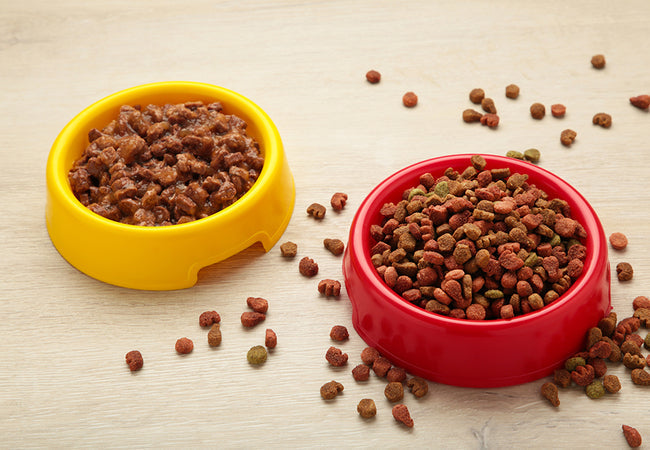Dry vs Wet Dog Food in 2025: A Vet’s Thorough Comparison 🐶🥣

In this article
Dry vs Wet Dog Food in 2025: A Vet’s Thorough Comparison 🐶🥣
By Dr. Duncan Houston BVSc
1. Introduction 🌱
Choosing between dry kibble and wet canned food is a common conundrum for dog parents. Both forms can nourish your dog, but which suits your pup’s health, age, lifestyle, and your daily routine best? As a practicing veterinarian, I’ll help decode key differences, nutritional factors, financial considerations, and smart ways to combine foods for balanced care in 2025.
2. What Differentiates Dry and Wet Dog Food?
Dry dog food (kibble) contains about 6–12% moisture, comes in bags, is shelf-stable, affordable, and promotes dental abrasion.
Wet dog food (canned/pouched) has ~60–78% moisture, richer aroma, fewer preservatives, and often higher meat and fat on a dry-matter basis.
Semi-moist falls in between (20–45% moisture) but often contains more sugar and salt.
3. Nutritional Comparison
Protein, Fat & Carbohydrate Content
On a dry-matter basis, wet food often has more protein and fat while kibble contains more carbohydrates. dogs digest carbs well, so this isn’t negative unless your dog needs a low-carb diet.
Moisture & Hydration
Wet food’s high moisture content supports hydration—beneficial for older dogs, kidney or urinary health—but any AAFCO-complete food allows dry-fed dogs to stay healthy with proper water intake.
Ingredients & Preservatives
Canned foods often avoid synthetic preservatives due to airtight packaging. Kibble uses preservatives like BHA/BHT/ethoxyquin—safe in regulated amounts, but ingredient quality varies widely.
4. Pros & Cons
| Pros | Cons |
|---|---|
| Dry Food: Affordable, long shelf life, supports dental health, easy portioning | Low moisture, less palatable, potential preservatives, harder for dental-sensitive dogs |
| Wet Food: Highly palatable, ideal for fussy or older dogs, hydrates, fewer synthetic preservatives | More expensive, less shelf-stable after opening, can promote dental plaque, and higher calorie volume |
5. Health & Life‑Stage Considerations
Dental Health
Kibble’s crunch helps scrape plaque, but it doesn’t replace tooth brushing. Wet food tends to stick and require more dental care.
Appetite & Palatability
Wet diets better appeal to picky, elderly, or recovering dogs with low appetites.
Weight Management
Because wet food is bulkier per calorie, it may help dogs feel fuller while consuming fewer calories, useful in weight-loss programs.
Health Conditions
Wet diets support hydration in conditions like kidney disease or urinary issues. Dry diets are better for grain-inclusive nutrition unless medically contraindicated.
6. Budget & Practicality
Dry food offers large quantities at a lower cost and easy storage. Wet is 1.5 to 3× more expensive per calorie, heavier, and requires refrigeration after opening.
Choose based on your budget, eating habits (e.g., grazing vs scheduled meals), and logistics (e.g., travel, senior care). Mixing can balance cost and appeal.
7. Is Mixing Wet and Dry Right?
Blending wet and dry food gives hydration, flavor, texture, and dental support. It’s increasingly common and recommended by vets—just be sure to adjust portions and monitor spoilage risks.
Use 25–50% wet food to enhance meals without excessive cost; ensure total calories match daily needs.
8. Transitioning Safely
Switch diets gradually over 7–10 days, starting with 25% new food and increasing slowly to avoid GI upset. Probiotics may aid transition.
9. Real‑Life Case Examples
Case 1: Senior Labrador with Dental Issues
Roxy, 10, had dental pain and a picky appetite. Switching to a soft canned diet resolved eating problems and boosted hydration. Regular dental chews helped maintain oral health.
Case 2: Overweight Beagle on Mixed Meals
Buster, a plump beagle, lost 12% body weight in 3 months by eating ~30% wet food and controlled portions, feeling full while consuming fewer calories.
10. Vet Guidance & Tools
- 📱 Ask A Vet App: Personalized advice on calorie needs, diet switching, and health monitoring.
- 🍽️ Woopf & Purrz Meal Mixers™: Vet‑formulated toppers to boost nutrition and enjoyment.
- 🎓 Nutrition Webinars: Learn portion control, label reading, nature of each diet type.
11. Making the Best Choice
- Assess your dog’s age, dental health, appetite, hydration needs, and lifestyle.
- Review AAFCO statements on food labels—choose “complete & balanced.”
- Check ingredient quality: named proteins, minimal fillers/preservatives.
- Decide based on your budget and practicality; mixing often offers best of both.
- Shift diets slowly and monitor your dog’s weight, coat, stools, appetite.
- Visit your vet for guidance—especially for health or dental concerns.
12. Final Takeaway
Both dry and wet dog foods can be excellent. Kibble is economical, convenient, and supports dental health, while canned options offer hydration and appeal to picky eaters. As of 2025, the smartest approach blends nutritional quality with your dog’s specific needs and your family’s routine. Don’t hesitate to adopt a hybrid feeding plan—it may deliver optimal health, wellness, and joy.
For tailored support, head to AskAVet.com or download our app. Your dog’s wellbeing is worth the thought you put into every bite 🐾❤️.






